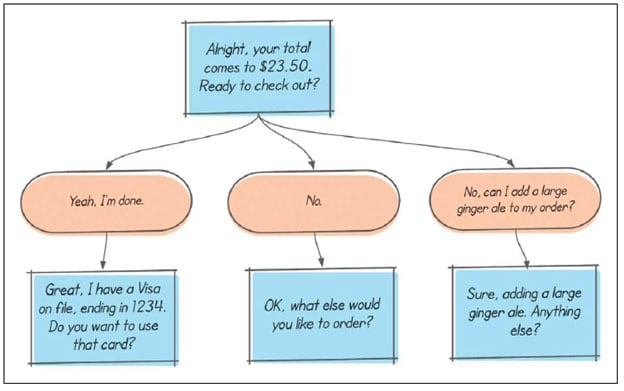A review of
 Conversations with Things: UX Design for Chat and Voice
Conversations with Things: UX Design for Chat and Voice
by Diana Deibel and Rebecca Evanhoe
Rosenfeld Media, LLC
300 pages, 11 chapters
About this book
A good reference for Methods/How-To and Case Studies
Primary audience: Researchers, designers, and technical roles who are new to the topic, have some experience with the topic, or have significant experience with the topic
Writing style: Humorous/light, Matter of fact
Text density: Equal parts text and images
Learn more about our book review guidelines
Anyone who has ever been asked to design for chat or voice, been curious about chat or voice design, or wanted to make the leap into this specialty design discipline owes a debt of gratitude to Diana Deibel and Rebecca Evanhoe. Their book Conversations with Things: UX Design for Chat and Voice is a guidebook to everything we need to know about chat and voice design. Rich in data, experience, and relatable anecdotes, this book is easy to engage with and offers something to readers at any level of experience.
These two industry veterans have unpacked chat and voice design for folks creating conversational interfaces, anyone in a UX role, anyone on a product team engaging with conversational design, and general readers curious about the design of these everyday devices. In addition to these targeted audiences, I would add students, educators, and advocates concerned with privacy and inclusivity.
The usability of this book is high. It begins with an explanation of who should read it, what is in it, what online resources come with it, and where to start. There is even a frequently asked questions and answer section with suggestions for readers short on time or experience. This open and direct acknowledgement—that we are all humans with too much on our plates and we don’t all start from the same knowledge base—sets the tone and creates a bond of mutual understanding between author and reader, which characterizes the reading experience from the introduction to the end credits. Each chapter builds upon the previous one and stands alone with just enough relevant information repeated in the right sections.
Deibel and Evanhoe give the impression that they have read everything and spoken to everyone so that you don’t have to. The writing is clear and candid with definitions, explanations, cheat sheets, and checklists. Sprinkled between the tactical design advice, readers will find anecdotes from the authors’ own experiences that will resonate with anyone who works with other humans. We are treated to snippets of chat conversations between the authors that show us their points of view and where those views diverge and converge. They took the time to disagree with each other, so we don’t have to! Deibel and Evanhoe have achieved a rare thing: a book written by and for experts that is accessible to anyone.
Deibel and Evanhoe’s dedication to an accessible and inclusive experience goes far beyond style and tone. Every section of the book from the introduction through the final chapter dedicated to “Designing Inclusive Conversations” (chapter 11) addresses accessibility and inclusivity best practices in some small or large way. Readers will find well-placed and considered primers on inclusive codesign and research recruitment inside and outside the chapter on “Researching and Prototyping” (chapter 10). There are sections on racial and gendered stereotypes (chapters 1–3), sexual harassment (chapter 4), domestic violence (chapter 8), ethics and data privacy (chapter 7), accessibility, localization, multilingual support (chapter 8), and the many things that can go wrong when designing for chat and voice (chapter 11).
In the section called “Darkest Timeline” (in chapter 11), the authors urge designers to question what can go wrong even under the best circumstances. What happens when someone uses our products to harm themselves or others? We don’t interrogate our designs or stress-test our products often enough to prevent harm. These are not just edge-cases, Deibel and Evanhoe remind us. And neither are those instances in which we avoid supporting marginalized users by labeling their needs edge-cases (also in chapter 11). This book is a good reminder of the living, breathing humans we are meant to be centering in our human-centered design.
Packed into 286 thorough and thoughtful pages (not counting the index or acknowledgements) is everything we need to know to be better designers and consumers of the products we keep in our pockets and on our kitchen counters. Why do we need a book to help us teach machines to do a thing we have been doing every day such as talking to each other? It is because we do it every day without examining the mechanics of it. Chapter 1 sets up a mutual understanding with readers and defines conversational interfaces as conversations between humans and “non-human things that do their best to listen, speak, and chat similarly to the way humans do” (2). Chapter 2 breaks down talking like a person. We learn how much non-verbal factors, like a thumbs-up, smile, or groan, convey meaning in a conversation and how hard that conversation can be when extra-linguistic inputs, such as body language, facial expressions, or mutterings, are missing. The authors explain concepts like turn-taking (your turn, my turn, and your turn), timing (the interval between turns), conversational repair (prompting a person to repeat or clarify), barge-in (interrupting), and accommodation (mirroring a conversational partner’s speed, volume, tone, or word choice). These are basic concepts of human speech that so many of us take for granted. Chapter 3 discusses chat-bot and voice-bot personalities, stereotypes, and trustworthiness. Should your bot have a name, a pronoun, or a backstory? Maybe it should if you are making deliberate choices that prioritize users over idealized brand promises.
Chapters 4–6 dig into the design details. In chapter 4 you will learn about designing prompts including those questions or cues like “What can I help you with?” that get a conversation started and keep it going until a user completes a task successfully or needs help from a human (you must design that part, too!). Chapter 5 addresses user intent and the old, but still applicable, information architecture like bucketing, which categorizes intents to cue the appropriate prompts and pathways. Conversational pathways are the subject of chapter 6. Here the authors discuss how to start with and expand on even older concepts like flow diagrams that map the decision-tree of a conversation. They demonstrate how to turn flows into scripts one branch of the conversation at a time. For instance, you should script a pathway for “new customer onboarding success” separately from the script for “new customer onboarding failure.” My prediction from reading chapters 4–6 is that counting the number of turns it takes to get your question answered by a bot will soon replace counting clicks used in the early days of web design.

Figure 1. The beginnings of a flow diagram from chapter 6 (figure 6.3).
Chapters 7–8 address the advanced design considerations of context and memory (chapter 7) and complex conversations (chapter 8). There is an improbable, yet comprehensible, amount of content jammed into these 55 pages. Readers will discover the difference between bots that have pronouns and bots that understand pronouns. A users’ context and a bot’s short- or long-term memory determine how, and how well, a user can build a relationship with that bot. A bot’s memory and understanding of context is dependent on data sharing. Deibel and Evanhoe remind us that data sharing—like all sharing—should be consensual and the result of opting in. Data transparency goes hand-and-hand with building context and building trust. “The part you might have influence over [as a designer] is giving users that transparency” (183).
Content and memory are also vital to multi-modal, multi-session, multi-channel, multi-person, and multilingual conversations (chapter 8). In multi-modal interactions, people will use many senses at once when there are screens to read or buttons to tap as well as spoken prompts to listen and respond to. This means voice, chat, and interface design are not mutually exclusive in audio, visual, and touch-based interactions. Designers also must strive for simplicity in multi-channel interactions if a bot sends you to a website, app, or email, or vice versa. Multi-session interactions are an opportunity to build a relationship between a customer and a bot; the bot can utilize short-cuts as a user revisits prompts, but again, only if the user has given the bot permission to remember (that is, store) past interactions. As Deibel and Evanhoe note, multi-person or group conversations and multilingual conversations could be the subjects of their own books. They tackle each in chapter 8 with pragmatic tips, case studies, and anecdotes.
Finally, in chapters 9–11 readers will find practical planning guides for implementation and launch including how to conduct inclusive testing (chapter 9) and how to start small and fine tune your product (chapter 10). Deibel and Evanhoe advocate for smart refinements and incremental releases over the stereotypical tech approach of going big and fast and breaking things. After all, the things that could get broken are your brand and your customers. Why risk it?
You Can’t Predict It All
Here is a great example of a surprise that Diana encountered when she designed an automated phone call to gather data on flu shot compliance. After it launched, she was examining transcripts for unexpected utterances and flows to improve the experience. During the conversation, the bot asked, “It’s OK if you’re not exactly sure, but about when did you last have your flu shot?”
That is a great prompt! It takes the pressure off by helping people understand that they needn’t be exact. On the back end, the system was set up to accept a variety of utterances in response:
• Full numerical dates like “November 5, 2019.”
• Contextual windows of time, like “last fall” or “I just got one on Tuesday.”
• Uncertainty, like “I can’t remember.”
Pretty thorough, right? What they completely missed was this perfectly logical response: “Hang on—let me grab my calendar.” These utterers were people who had clearly had a flu shot and were willing to comply with the call. But because the team didn’t fully account for users’ situations in space and time, in the launched version of the bot, these responses yielded an error message. Although it is an issue that many users bumped into errors despite their perfectly logical responses, what is worse was how this actually impacted the resulting data. The people who indeed had flu shots weren’t counted. Talk about a bummer! In situ usability testing could have turned up this behavior sooner.
After 20 years in tech, I still consider myself a cautious adopter. Or perhaps it is because of those 20 years that I am skeptical about, and slow to embrace, chat and voice products. I’ve experienced enough gender-based harassment at work; there is no room in my life for devices that are designed to assist but that, in fact, perpetuate any kind of discrimination. That is why I believe Diana Deibel and Rebecca Evanhoe’s book Conversations with Things: UX Design for Chat and Voice should be required reading for anyone participating in the design or development of chat and voice products now and in the future. As I make the transition to full-time teaching, I can honestly say this book will be required reading in my classroom, and not just when we are discussing conversations with things.
Sarah Pagliaccio is an educator and UX consultant working at the intersection of tech, the arts, and humanness. Sarah believes computer-human interactions should be characterized by transparency and dignity. That is the message she strives for in her design work, writing, and teaching at Bentley University.

